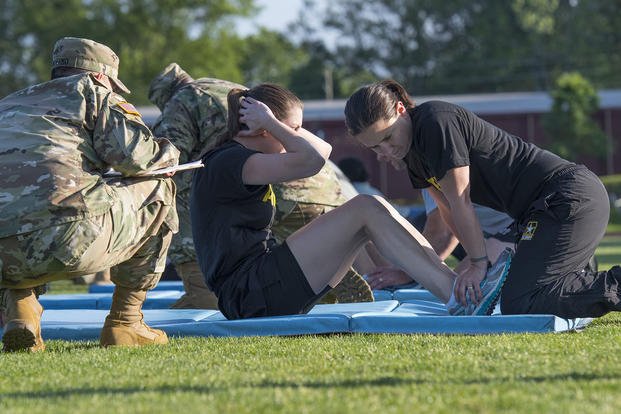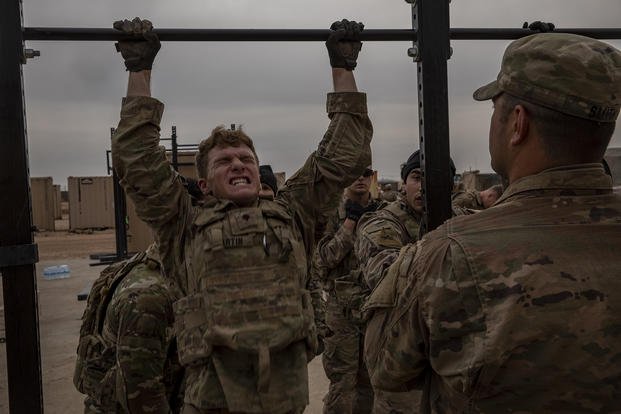I received a fairly basic question about PT pyramids. I realized what some groups consider standard knowledge, others, especially young, future military members, may not know or understand. The PT pyramid is a great way to build a foundation of fitness needed to ace any physical fitness test. The pyramid program has a warmup, max-out and a cooldown built into it, making it a very healthy way to exercise.
The pyramid described in this article is for pull-up, push-up and sit-up workouts and can be done anywhere. I do this workout at my local elementary school playground on monkey bars. This workout is a staple in many of the eBooks found on the Military.com eBook Fitness Store and can be utilized with squats, lunges, any abdominal exercise, dips and even running. As you advance, you can increase the steps up as high as you wish. At SEAL training, we did a pull-up pyramid up to 15 and back down to one. That equals 225 pull-ups.

How the Pyramid Works
If you take a look at one of the pyramids, you will notice that it is numbered on both sides. It goes from 1-5 on one side, with the number 6 on the top and then 5-1 on the other side. Each number represents a step in the pyramid. Your goal is to climb the pyramid all the way up, then all the way back down. So you can consider each step a "set" of your workout.
At the bottom, you will find "pull-ups x1, push-ups x2, sit-ups x3." What this means is that at each "set," or step of the pyramid, you perform one pull-up for every step you are on, two push-ups for each step and three sit-ups for each step.
You start at the bottom of the pyramid, at number one. For each set, you multiply each set number by one, and that tells you how many pull-ups to do. You multiply it by two to get your push-ups and multiply by three for sit-ups. You keep progressing until you get to the top of the pyramid, or your maximum effort at muscle failure.
At step six, you perform six pull-ups, 12 push-ups and 18 sit-ups. Now start working your way back down the other side and continue on step five on the way back down. So you'll do five pull-ups, 10 push-ups and 15 sit-ups. Keep going until you get down to one. Listed below is a number summary of the pyramid:
Go Up the Pyramid
(or half pyramid workout)
- Set/Step 1: 1 pull-ups/2 push-ups/3 sit-ups
- Set/Step 2: 2 pull-ups/4 push-ups/6 sit-ups
- Set/Step 3: 3 pull-ups/6 push-ups/9 sit-ups (Your first few sets are basically a warmup.)
- Set/Step 4: 4 pull-ups/8 push-ups/12 sit-ups
- Set/Step 5: 5 pull-ups/10 push-ups/15 sit-ups
- Set/Step 6: 6 pull-ups/12 push-ups/18 sit-ups (Here is where you may fail/max out.)
Go Down the Pyramid
(or reverse order pyramid)
- Set/Step 5: 5 pull-ups/10 push-ups/15 sit-ups
- Set/Step 4: 4 pull-ups/8 push-ups/12 sit-ups
- Set/Step 3: 3 pull-ups/6 push-ups/9 sit-ups (finish cooldown)
- Set/Step 2: 2 pull-ups/4 push-ups/6 sit-ups
- Set/Step 1: 1 pull-ups/2 push-ups/3 sit-ups
Here are other creative ideas:
- Add dips to the exercises for an additional triceps/shoulder burn. I usually do the same number of dips as I do push-ups.
- Run a 100-yard or even quarter-mile sprint. These will challenge you tremendously, and you will lose your energy quickly so bring Gatorade for blood-sugar/electrolyte replacement and water to drink.
Stew Smith is a former Navy SEAL and fitness author certified as a Strength and Conditioning Specialist (CSCS) with the National Strength and Conditioning Association. Visit his Fitness eBook store if you're looking to start a workout program to create a healthy lifestyle. Send your fitness questions to stew@stewsmith.com.
Want to Learn More About Military Life?
Whether you're thinking of joining the military, looking for fitness and basic training tips, or keeping up with military life and benefits, Military.com has you covered. Subscribe to Military.com to have military news, updates and resources delivered directly to your inbox.





















